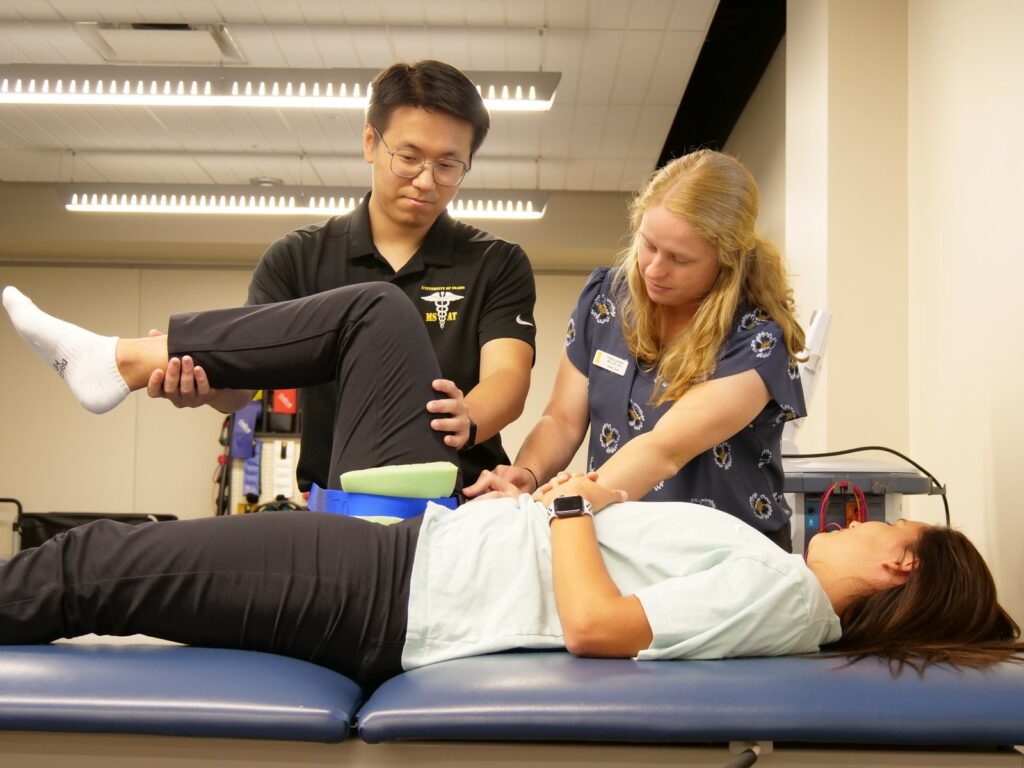One of the most common questions our faculty and staff hear from people outside the profession is “What do athletic trainers do?” According to the National Athletic Trainers Association (NATA), “Athletic trainers (ATs) are highly qualified, multi-skilled health care professionals who render service or treatment, under the direction of or in collaboration with a physician, in accordance with their education, training and the state’s statutes, rules and regulations. As a part of the health care team, services provided by athletic trainers include primary care, injury and illness prevention, wellness promotion and education, emergent care, examination and clinical diagnosis, therapeutic intervention and rehabilitation of injuries and medical conditions.”
While this broad description is helpful, potential students are often looking for more specific descriptions. They ask: what are the responsibilities of an athletic trainer? What settings do athletic trainers work in? What patient populations do they serve? How many hours do they work? What are an athletic trainer’s daily duties?
There is no one-size-fits-all answer, as the duties vary so much between athletic trainers in different settings. An athletic trainer job description for someone in a physician’s office is going to look very different from the athletic trainer job description of someone working for a university soccer team. This allows for great flexibility within the profession, and allows for ATs with different strengths and goals to find their own niches to thrive in.
Let’s look at a few of these questions.
What do athletic trainers do?
Although they can be found in a variety of settings, the role of an athletic trainer always focuses on the prevention, assessment, treatment, and rehabilitation of various injuries and illnesses. In some situations, they may work predominately in preventative care, where they monitor equipment and conditions, write safety plans, and design procedures should an injury occur. Others may work in a clinical setting, where most of their patients have already sustained an injury and are working on treatment, rehabilitation, and prevention of future injuries. And some work in settings where their athletic trainer daily duties consist of doing all four pieces.
Where do athletic trainers work?
As mentioned above, athletic trainers are found in a variety of settings. They are found on the sidelines of professional and collegiate teams, in rural hospitals, high schools, in the performing arts, industrial settings, with the military, and in public safety. In some settings like a professional sport’s team, an athletic trainer might be part of a larger staff comprised of many individuals from many fields. In other situations, such as a high school, they may be the only athletic trainer on staff.
What patient populations do athletic trainers serve?
Although athletic trainers can (and do!) serve people in all walks of life, they are most commonly found serving active populations. This may be athletes, performers, military personnel, public safety employees, and employees in industrial settings.
How many hours a week do athletic trainers work?
Athletic trainers are typically employed full time. Some settings require more hours than others. For example, an athletic trainer in a rural school district may work untraditional hours to provide care [SM(1] for after-school practices and competitions on evenings and weekends. Likewise, an athletic trainer for a professional athletic team likely travels with the team which tends to extend beyond 40 hours a week when the team is in-season. Athletic trainers in clinic and industrial settings frequently have much more predictable hours.
What does a day in the life of an athletic trainer look like?
Mika Rives is a Doctor of Athletic Training student and practicing clinician in our on-campus clinic (ISMaRT Clinic). We sat down with him while he shared about his role as an athletic trainer and what his daily responsibilities and duties entail.
I work in a sports medicine clinic run by athletic trainers. The typical patient in the clinic is a student at the university with a musculoskeletal injury. However, we work with students, faculty/staff, and members of the community. We cover a variety of patient presentations providing orthopedic evaluations and utilizing mindfulness, prophylactic taping, motivational interviewing, manual therapies, modalities, therapeutic exercises, energy medicine, breathing, and joint mobilizations. The clinic setting is a very relaxed and positive environment.
I work directly with a handful of patients that I see regularly throughout the week. I also oversee and advise athletic training students as they work directly with the patients in the clinic. I work with athletic training students to reflect on patient care, improve clinical reasoning, and review athletic training competencies and proficiencies.
In addition to my time in the clinic, I also cover club sporting events, providing emergency care, and performing sideline evaluations.
In conjunction with my clinical duties, I am a teaching aide for the clinical experience and clinical education classes for the athletic training program at my university. I also am pursuing my doctorate in athletic training and do research on my patient care.
Conclusion
Athletic training is not as well-understood by the public as nursing or physical therapy. However, for many it is an exciting career choice that can combine passions for health, active lifestyles, and patient care. If you’re interested in learning more about athletic training and how you may fit into this career, we’d love to hear from you! You can reach out to any of our faculty/staff or at ui-at@uidaho.edu.
